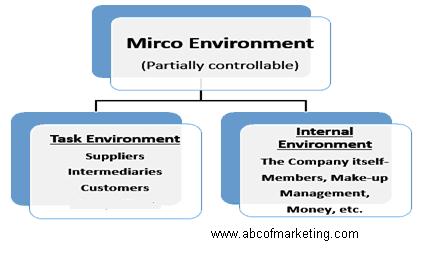Discuss the Micro environmental bases for International markets.
 Email This Post
Email This Post
The Micro environment variables are partially controllable. The management can adjust them to gain maximum advantage.
Micro environment is divided into two parts, the Task Environment and the Internal Environment.

The Task environment is made up of suppliers, Intermediaries, customers and competitors. The task environment has factors external to the organisations but are partially controllable by the organisation. Analysis of the infrastructure, roads, transportation and communication facilities affect the distribution and promotion activities in foreign land. For example, Apple attributed less sales of its iPhone’s in India because of no LTE network launch in 2015 and 2016. LTE network was available to customers in late 2016. This was made available by only few mobile carriers. For entering the Indian market, Motorola signed exclusive contract with ecommerce giant Flipkart for sale of its phone. The launch was a huge success with stocks sold out within 20 minutes of its launch. Selecting the right intermediary in the international market is very important.
Internal Environment includes factors that are internal to the organisation and are partially controllable by the organisation. The Internal environment refers to the Company itself sometimes referred to as 7M’s of an organisation – Members, Make-up, Management, Money, Machinery, Materials and Markets.
a) Members –
Human resources information: organization will need to invest in training the new staff in the new county. The capability of the existing staff will give an idea to the management if they need to hire local employees or transfer existing employees to the new international market. A comprehensive analysis will have to be done about the staff availability in the new market if needed.
b) Money –
Financial condition and availability of capital: shareholders interest in investment, ability to take loans, current and future financial returns, ability to handle interest rate changes, etc.
c) Make-up –
Organizational culture and structure: the geographical spread, power structure to understand centralized or de-centralized, reporting structure of new facility.
d) Management –
Experience, stability of senior and middle management,
Responsibilities and coordination amongst the management team.
Quality of decision making,
Their career path, performance and plans of succession
e) Machinery –
Capital equipment requirements, technological capability: able to make a new product ormodify the new product with current machinery,
Depreciation, decisions of investment in new plant,
Maintenance and quality, etc.
f) Materials –
Purchasing and supply, if the proprietary ingredients will be supplied from existing market or acquired from new country, supply management and costs: consistent supply from the suppliers in new country, dependence on the suppliers, etc., assembling of the raw materials.
g) Markets –
Current markets served, dependence on existing products, financial returns, same marketing functions can be implemented in the new international market or changes are required, etc.
The company or the organisation has to ensure that it is capable of handling international markets by considering the micro environmental factors.
